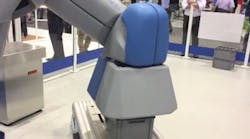Robots are always the main attraction at Automate, and Comau did not disappoint with its robotic workstation demonstration that included both industrial and collaborative robots as well as an automated guided vehicle (AGV). Of particular interest in this display was Comau’s approach to collaborative robots (cobots). Whereas most examples of cobots are smaller, specially designed robots built to work safely alongside humans—often in tight quarters—Comau has approached the concept by transforming an existing industrial robot platform into a collaborative robot.
Comau calls its collaborative robots AURA (Advanced Use Robotic Arm). Explaining AURA, Comau says these robots are equipped with sensors installed under a layer of protective foam to ensure “total safety.” AURA robots employ laser scanners to identify the positions of persons or other objects in the area dynamically, making it possible to ramp down the motion of the robot to a complete stop when it is very close to or in contact with the worker. The AURA robots also include a vision system, integrated into the robot controls, that transmits data regarding the proximity of persons to the robot's area of action, enabling software to predict their movements and modify the robot's trajectory accordingly. This vision system also guides AURA’s picking and placing actions.
In the video below (under the ad), you can see how Comau has created an example application featuring an industrial robot picking a bin off a conveyor, transferring the bin to an AGV, which then transports the bin to an AURA robot for further handling. Once this process is complete, the AGV returns to the initial position to repeat the process.
Comau says all components in this workstation—robots and AGVs—transmit all operating data digitally for automated cooperation among devices in the workstation as well as for storage and analysis to continuously optimize operations.
Leaders relevant to this article:


